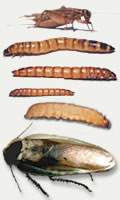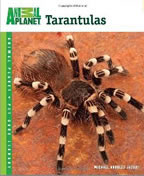Basic Tarantula Care
© 2000-2013, Michael Jacobi and TARANTULAS.com
Introduction
This page provides basic guidelines that will help new tarantula keepers successfully maintain their pets. It is a concise overview of good tarantula husbandry practices. It is not meant to provide all information essential to tarantula keeping. To learn the specifics of caring for young tarantulas please see Raising Young Tarantulas. Please also visit our Care Videos page to watch excerpts from the "Tarantulas in the Terrarium" instructional film on YouTube™. We recommend that you also read at least one of the books suggested in the sidebar of this page (Tarantulas and Other Arachnids and The Tarantula Keeper's Guide). It is also important to research the specific needs of the species you have chosen, especially with regards to temperature and humidity.
Housing
Tarantulas should be housed in small enclosures that are safe and secure. Care should be exercised to ensure that the enclosure is safe from other pets such as dogs and cats and placed out of reach of children. Locate it in an area out of direct sunlight and drafts and where there is little disturbance from vibration such as heavy foot traffic and loud music. It is also important to remember that nicotine is a powerful insecticide and tarantulas are best kept far away from tobacco smoke.
New keepers often use too large of enclosures. Tarantulas naturally live in burrows or other small confined spaces and need the security of a small space. A small cage also allows you to easily monitor its feeding so you can promptly remove uneaten food. As a rule of thumb, an enclosure should be two or three times the legspan of the tarantula in both width and length. It is also highly recommended that the distance from the top of the substrate to the top of the cage be no more than the legspan for terrestrial [ground-dwelling] species. This is to prevent injury from a fall. In the unnatural situation of captivity, some heavy-bodied tarantulas that would normally not climb in the wild will explore the tops of their cages. This can be a dangerous situation that can easily be avoided by using shorter enclosures and deep substrate.
 You can keep your tarantula in a very simple and inexpensive plastic container with numerous air holes in the sides and lid, or a more expensive glass terrarium container with a screen lid. Perhaps the most popular tarantula cage is the plastic Kritter Keeper™ or Herp Haven™. These small terrariums have a snap-on well-ventilated lid with an access door. They can be found at most pet shops and some superstores, and there are some new models that are shorter in height and excellent for terrestrial tarantulas. These low-profile models are marketed with names like "Lizard Lounge" or "Breeder Box". Clear, plastic storage containers, which are sold as shoe boxes, sweater boxes, etc. and manufactured by companies like Rubbermaid™ and Sterilite™ are very popular with tarantula breeders and others housing large numbers of tarantulas. They don't make for very attractive displays, but with the addition of ventilation holes drilled in the sides and top they make very functional tarantula enclosures.
You can keep your tarantula in a very simple and inexpensive plastic container with numerous air holes in the sides and lid, or a more expensive glass terrarium container with a screen lid. Perhaps the most popular tarantula cage is the plastic Kritter Keeper™ or Herp Haven™. These small terrariums have a snap-on well-ventilated lid with an access door. They can be found at most pet shops and some superstores, and there are some new models that are shorter in height and excellent for terrestrial tarantulas. These low-profile models are marketed with names like "Lizard Lounge" or "Breeder Box". Clear, plastic storage containers, which are sold as shoe boxes, sweater boxes, etc. and manufactured by companies like Rubbermaid™ and Sterilite™ are very popular with tarantula breeders and others housing large numbers of tarantulas. They don't make for very attractive displays, but with the addition of ventilation holes drilled in the sides and top they make very functional tarantula enclosures.
Tarantulas do not require plants or decorations, but they can be used if you want to make your pet's home more attractive. Silk or plastic plants are much more durable than live plants, and they eliminate the possibility of the substrate and cage becoming too wet due to watering. Of course, fake plants also do not require light and tarantulas prefer dark cages. Cork bark, hollow logs and driftwood are attractive items to decorate with and can provide your tarantula with a welcome hiding place. Avoid any items that have sharp edges or are excessively rough in texture. Also avoid any decor from outdoors that may harbor pest or carnivorous insects or may have been exposed to pesticides, fertilizers or other hazardous materials. When designing your enclosure remember that terrestrial (ground-dwelling) tarantulas like more ground space and a deeper substrate, whereas arboreal (tree-dwelling) tarantulas need taller enclosures with a piece of cork bark or similar item to climb and attach silk nests.
Substrate
 Any sort
of clean and natural dirt free of pesticides and fertilizers is good.
Chemical-free top or potting soil, peat moss and coconut coir [popular
as a reptile substrate and sold in compressed bricks as Eco-Earth™,
Forest Bed™, Bed-A-Beast™, etc.] are excellent tarantula substrates.
Horticultural vermiculite can also be used with great success, but it
is unnatural in appearance, dusty and some products may contain asbestos-like
substances. Do not use sand [except as a small part of a mixture containing
mostly soil or peat], gravel, perlite or corn cob or any other type of
small animal bedding, especially cedar shavings. The substrate should
be as deep as the container allows, at least a couple of inches whenever
possible. This will allow you to pour some water down the side and have
the bottom depth damp while the surface in contact with the spider is
dry. Ideally, it is good to have a slightly damp corner—usually
where the water dish is—at one end while the other end of the tank
is dry. Over time this water will evaporate and provide beneficial humidity.
Replenish as needed taking care to not saturate the substrate.
Any sort
of clean and natural dirt free of pesticides and fertilizers is good.
Chemical-free top or potting soil, peat moss and coconut coir [popular
as a reptile substrate and sold in compressed bricks as Eco-Earth™,
Forest Bed™, Bed-A-Beast™, etc.] are excellent tarantula substrates.
Horticultural vermiculite can also be used with great success, but it
is unnatural in appearance, dusty and some products may contain asbestos-like
substances. Do not use sand [except as a small part of a mixture containing
mostly soil or peat], gravel, perlite or corn cob or any other type of
small animal bedding, especially cedar shavings. The substrate should
be as deep as the container allows, at least a couple of inches whenever
possible. This will allow you to pour some water down the side and have
the bottom depth damp while the surface in contact with the spider is
dry. Ideally, it is good to have a slightly damp corner—usually
where the water dish is—at one end while the other end of the tank
is dry. Over time this water will evaporate and provide beneficial humidity.
Replenish as needed taking care to not saturate the substrate.
Drinking Water
Although tarantulas acquire most of their water from their food, it is a good idea to provide a small, shallow dish of fresh water to adult tarantulas. The natural evaporation will also provide beneficial humidity. It is more difficult to provide a water dish to small tarantulas, but a spider with a legspan of a 50-cent piece or so is large enough for a simple tiny water receptacle such as a 2-liter soda bottle cap. Provide clean tap water—do not use "cricket gel" or sponges, which just get dirty and funky with bacteria and mold and do not provide sufficient moisture. Water can also be provided by lightly misting the substrate and/or sides of the enclosure. Never spray the spider directly and take care to not create overly damp conditions. Most pet tarantulas are grassland or desert species that should have a mostly dry cage, although having a small, damp area near the water dish can be helpful [see Substrate above]. Tropical species require elevated humidity. Research your pet's needs and provide accordingly.
Climate
Most tarantulas can be kept in the range of 70-75 degrees Fahrenheit, which is room temperature in a warm home. In other words, most tarantulas do not require supplemental heat in all but the coolest households. Some tropical species may require temperature in the upper 70s during the day, but no tarantula should be kept much above 80 for any extended periods of time. A fluctuating temperature is best, with nights cooler than days.
When kept cooler than optimum tarantulas will become inactive, but should be in no danger at temperatures comfortable to you. If heat is required it is best to use a very small reptile heat pad placed near the enclosure or on the side of a larger tank, but not beneath or in direct contact as you would use it for a reptile. The use of lights for heat should be avoided as tarantulas prefer dark conditions and radiant heat sources such as bulbs create overly dry conditions, but a black or red incandescent bulb placed several feet away from the cage can be an effective heat source if used carefully. Keep in mind that the warmer you keep your tarantula, the higher its metabolic rate will be. It will want to eat more often and will grow more quickly. It will also dehydrate quicker so you must be very observant of the environment and diligent with care. If your tarantula species requires moderate to high humidity, you can provide this by keeping the substrate partially or mostly moist. If you use a light for heat and display, be sure to monitor the humidity levels closely. Turn the light off at night unless it gets below 65 degrees in your house. It is advisable to let the temperature decrease as much as 10 degrees at night, especially for desert tarantulas.
Food
 Tarantulas
will eat crickets, grasshoppers, katydids, moths, beetle larvae (e.g.,
mealworms or superworms), houseflies and cockroaches. Some tropical tarantulas
readily accept earthworms, and some larger tarantulas will accept live
baby rodents, lizards, and snakes. When feeding, a good rule of thumb
is to offer prey items that are about half the spider's legspan or just
slightly smaller than the length of its body. For example, a 2-inch legspan
juvenile tarantula with a body length just under an inch can be offered
a half to three-quarter-inch cricket [3-4 week-old]. However, some tarantulas
are aggressive eaters and will eat prey as large as themselves. As a rule,
live prey is required, however, some tarantulas will scavenge on dead
animals. This is especially true of young tarantulas, and it is often
possible to rear tiny spiderlings by cutting an adult cricket into two
or three pieces and offering one section. For young tarantulas, one prey
item of suitable size is appropriate. If you are feeding comparatively
small prey to a large tarantula, such as adult crickets to an adult "Rose
hair", you can offer 4-6 at one time. The spider will attack them
in succession and ball them up into one tidy meal. This ball of food and
silk that a spider ingests over time is called a bolus.
Tarantulas
will eat crickets, grasshoppers, katydids, moths, beetle larvae (e.g.,
mealworms or superworms), houseflies and cockroaches. Some tropical tarantulas
readily accept earthworms, and some larger tarantulas will accept live
baby rodents, lizards, and snakes. When feeding, a good rule of thumb
is to offer prey items that are about half the spider's legspan or just
slightly smaller than the length of its body. For example, a 2-inch legspan
juvenile tarantula with a body length just under an inch can be offered
a half to three-quarter-inch cricket [3-4 week-old]. However, some tarantulas
are aggressive eaters and will eat prey as large as themselves. As a rule,
live prey is required, however, some tarantulas will scavenge on dead
animals. This is especially true of young tarantulas, and it is often
possible to rear tiny spiderlings by cutting an adult cricket into two
or three pieces and offering one section. For young tarantulas, one prey
item of suitable size is appropriate. If you are feeding comparatively
small prey to a large tarantula, such as adult crickets to an adult "Rose
hair", you can offer 4-6 at one time. The spider will attack them
in succession and ball them up into one tidy meal. This ball of food and
silk that a spider ingests over time is called a bolus.
How often you feed your tarantula is up to you. Some people want their spider to grow as fast as possible and will offer food almost every day. However, offering food every 4-7 days for young spiders and every 10-14 for larger specimens is a reasonable regimen. Do not feed freshly molted tarantulas for several days [young] to two weeks [adults]. Spiders, in general, will keep eating until they are full, approaching a molt, or ready to lay an egg sac. In a sense, you can't really overfeed young tarantulas, but this isn't the case with adults. An adult tarantula might only eat once a month or even as little as a few times a year in the wild. A tarantulas abdomen should not be overly large and impede its ability to move about with ease.
It is extremely important to remove any uneaten prey items whether live or dead within 24 hours or so. I recommend offering food late at night and removing it first thing in the morning if not accepted. Uneaten insects or other prey items can be stressful for the tarantula, and have been known to damage and even kill tarantulas if not eaten. Food remains like the bolus will attract pests and mold. It is advisable to remove the remains of any prey items from your tarantula's enclosure so that they do not cause unhealthy conditions for your pet.
Molting
Tarantulas are invertebrate animals that need to shed their complete exoskeleton in order to grow. This is the time when the tarantula is its most vulnerable. Molting may occur as often as once a month in young "spiderlings" or only once every year or two in adults. As a molt approaches, the tarantula may refuse food, sometimes for several weeks or even months prior to the process. If your tarantula refuses several offered meals in a row it may be about to molt. Further evidence of an impending molt is reduced activity, increased use of silk as it creates a web"molting mat" and dull coloration. Species that flick urticating hairs and have a "bald spot" on their abdomens are easy to assess. The light bald spot will become increasingly dark until it is almost black. If you believe your tarantula will soon molt it is extra important to make sure you remove uneaten food [you should always be doing this!] and pay close attention to temperature and humidity levels. A slight increase in humidity is recommended [add water to substrate at one end of cage and keep water dish full]. Leave the tarantula undisturbed, certainly do not touch or handle.
When a terrestrial tarantula molts it will turn onto its "back" (arboreal tarantulas molt on their backs or sides, often in a silken retreat above the ground where they may be vertical). Don't be alarmed. It is not dead. Dead tarantulas usually are 'right side up' and have their legs curled beneath their bodies. Pressure changes within the molting tarantula will cause its old exoskeleton to separate at the carapace and abdomen. It will pull its legs out of its old skin much like you pull your fingers out of a glove. The cast exoskeleton (or exuvium) looks much like a hollowed-out complete tarantula. Once the process is completed the pale-colored tarantula will rest for as much of a day and then spend the course of the next week or so with its legs outstretched as its short growing process occurs and its new exoskeleton hardens. Do not disturb or feed your tarantula for at least a week after molting. A young tarantulas may fully harden in three or four days, but an adult may require two weeks. It is extremely delicate at this time and can even be injured by attempting to flick urticating hairs off its soft abdomen. Leave it alone.
Handling
Some species of tarantula are known for their docile nature and are handled by some keepers. Others have defensive dispositions and are quick to bite. We do not recommend handling any tarantulas, primarily for the safety of the spider. Tarantulas are extremely fragile creatures that can easily be injured from a fall or other mishap. In addition, all tarantulas are venomous and have the ability to bite. Their venom may not be life-threatening, but it can cause severe pain and several days of muscle spasms and cramps. Tarantulas are untamed animals and unpredictable. They are terrarium pets like tropical fish or frogs and are best enjoyed through observation and care, not interaction.



